Biosecurity in aquaculture consists of practices that minimize the risk of introducing an infectious disease and spreading it to the animals at a facility and the risk that diseased animals or infectious agents will leave a facility and spread to other sites and to other susceptible species. These practices also reduce stress to the animals, thus making them less susceptible to disease.
Over the past decade, a number of important disease outbreaks in both U.S. aquaculture (spring viremia of carp, koi herpesvirus) and wild fish populations (viral hemorrhagic septicemia type IVb) have increased the industry’s awareness of the importance of biosecurity. Examining specific points in production when pathogens (disease-causing parasites, bacteria, viruses and fungi) may be introduced or disease may develop will help producers develop precautionary measures. Good biosecurity minimizes the fishes’ exposure and susceptibility to pathogens, reduces economic losses from mortalities, and helps prevent mandatory depopulation.
This publication provides an overview of major concepts in biosecurity for aquaculture. Although it concentrates primarily on finfish, the principles described also hold for other species groups. Because biosecurity management differs with the type of system, two additional publications will cover specifics for tank and recirculating systems (Part 2) and ponds (Part 3).
Major Goals of Biosecurity
Major biosecurity goals are:
- animal management—obtaining healthy stocks and optimizing their health and immunity through good husbandry
- pathogen management—preventing, reducing or eliminating pathogens
- people management—educating and managing staff and visitors
The ease with which a specific pathogen can enter a facility, spread from one system to another, and cause disease depends on:
- the species, immune status, condition, life stage, and strain susceptibility of the cultured fish;
- major environmental factors such as water quality, water chemistry, and husbandry practices;
- characteristics of the pathogen, such as biology and life cycle, potential reservoirs (carriers, other animals), survival on inanimate objects (equipment), options for legal treatment(s), regulatory status (exotic vs. endemic disease, reportability, and federal, state and local laws); and
- workers’ understanding of biosecurity principles and compliance with biosecurity protocols.
Animal and Population Management
Obtaining healthy animals (eggs, fry, juveniles, broodstock) from a reputable supplier is critical. Work with a fish health professional to determine species-specific health parameters and diseases of concern. Before obtaining animals from an outside source, learn as much as you can about their health, including where they came from, whether they have had any disease issues, and whether they have had any health examinations, disease testing, or treatments. Some suppliers offer animals that have tested free of specific pathogens and these animals are preferable. If information about animal health is unavailable or unclear, fish should be tested shortly after they are received.
Strains of some aquacultured species are known to be more resistant to specific diseases. Tracking the lineage/ genetics of your broodstock helps avoid inbreeding and ensure the production of healthy gametes and fry.
Good husbandry is also important to biosecurity. Any environmental conditions or procedures that stress the fish or that may damage the skin, fins, gills or intestine will weaken their immune systems and make them much more susceptible to disease. Good water quality/chemistry, nutrition, and handling methods will go far toward preventing disease.
Good preventive medical practices include quarantine, routine observation, vaccination, and the use of immunostimulants, probiotics, and diagnostics for disease management.
Quarantine is one of the most important animal management and biosecurity measures. Quarantine is the procedure by which an individual or population is isolated, acclimated, observed and, if necessary, treated for specific diseases before its release onto the farm or for live market sale (e.g., for growout or for aquarium fish stores). The principles of quarantine apply for new fish coming into a facility, fish moving from one area or system to another within the facility, and resident fish that become diseased.
Well-designed quarantine systems physically separate incoming fish from the rest of the farm. Water in quarantine systems also should be separate from that on the main farm, and discharges should be handled appropriately. Proper quarantine not only protects established populations from potential exposure to pathogens but also gives the new animals time to acclimate to water, feeds and management and to recover from handling and transport. Handling and transport have been shown to reduce disease resistance and recovery may take weeks.
Fish in the general population that become sick may have to be isolated in tanks in the same system or room as their healthy counterparts; signs or other methods should be used to alert employees that the population is diseased.
Major components of quarantine include all-in-allout stocking, isolation or separation, observation and diet adjustment, and sampling and treatment.
All-in-all-out stocking. This involves bringing animals in as a group from only one original source population and maintaining them as a group throughout the quarantine period. It prevents exposure to other pathogens not currently in that population. Ideally, no new animals should be added to a group currently in quarantine. All-in-all-out quarantine may involve an entire facility, room or system.
Isolation or separation. A group of animals in quarantine should be physically isolated from other quarantined populations and from the resident populations. Methods of isolation should be built into the facility and system design. If logistics prevent complete isolation, populations should at least be separated by tank or vat. Regardless of the level of isolation, appropriate sanitation and disinfection measures must be used to reduce cross-contamination between quarantined and established populations and between separate populations in quarantine.
Observation and diet adjustment. Animals should be observed for normal and abnormal appearance and behaviors throughout the quarantine period so disease problems can be detected early. Loss of appetite, for example, is a very common, early sign of disease. Good nutrition will increase disease resistance and careful adjustment from the diet of origin to the on-farm diet will reduce problems from sudden changes.
Sampling and treatment. Fish in quarantine should be sampled for specific diseases of concern at the beginning and end of the quarantine period and at any time that disease signs develop. Although complete necropsy evaluation of a number of specimens is best, limited sampling of more valuable specimens can be done without sacrificing the animals by examining small sections of skin, fin and gills for parasites and doing a blood culture for systemic bacterial infections. The results can then be used to improve quarantine methods and the use of drugs. Consult with a fish health professional to assist with this. Legal issues associated with drug usage should be considered before treatment.
Pathogen Management
Not all pathogens (disease-causing organisms such as bacteria, parasites, viruses and fungi) are of equal concern. Pathogens vary in their regulatory significance, survivability in reservoirs, pathogenicity (how easily they can infect and cause disease), diagnostics, and control. Although some pathogens cause disease more readily than others, environmental and host factors—especially the species and its immune status—will ultimately determine whether fish become sick.
Regulatory significance. Some diseases and pathogens are considered important internationally and listed by the OIE (World Organization for Animal Health) because of their economic or environmental importance. Many of these, or others, are also currently regulated or under regulatory consideration by the USDA?APHIS and/or by state and local governments. Outbreaks of some of these diseases require depopulation, which will greatly affect the operation. The proper authorities (local, state and federal) must be notified if a reportable disease is suspected or diagnosed on your facility. Work with a fish health professional to determine if your species is susceptible to any regulated diseases, and get professional assistance with disease diagnostics and management.
Reservoirs. Pathogens can survive and thrive in “reservoirs” within a facility. Non-living reservoirs include water, system components, equipment, floors and walls, and feed. Living reservoirs include the aquacultured animals themselves, other animals (such as frogs and birds), plants, and live (or frozen) food. Understanding the biology of pathogens is important, including the factors that permit them to survive in reservoirs and how easily they can be killed by common disinfectants.
High animal densities, biofilms and sediments can help concentrate microorganisms. Uneaten feeds and other organic matter in the system favor pathogen survival and spread. Aeromonas and Vibrio species are bacteria that prefer these highly organic environments. They can also infect and live within a fish, sometimes without causing disease. Another group of bacteria, the Streptococcus species, are not as common as Aeromonas and Vibrio but are difficult to eliminate once established within a system. Mycobacteria also live within biofilms that coat the tanks, filters and pipes. Some parasites, including trichodinids, sessile ciliates, Tetrahymena and Uronema, thrive in organic wastes and on dead or dying fish. Viruses vary in their ability to survive, but some viruses may persist for weeks or months. Likewise, fungal spores can survive for a long time in detritus.
Pathogens can enter facilities in aerosol (fine water droplets), on equipment and vehicles, and on people’s hands, arms and feet. Once inside, they may survive in pockets of moisture on the ground, walls or ceiling.
Pathogens can also be spread by other animals that live in or near ponds or tanks (birds, rodents, reptiles, insects, aquatic invertebrates). For example, midge fly egg masses (which develop into larvae sold as bloodworms) have been shown to harbor some Vibrio species. In addition to directly transmitting some pathogens, animals may also serve to complete parasite life cycles (e.g., white or yellow grub—digeneans, and myxozoans such as those that cause hamburger gill disease in catfish).
Pathogenicity. Pathogens differ in their ability to infect and cause disease. Some, like many Aeromonas and Vibrio bacteria common in aquaculture, are more opportunistic and cause disease only when environmental conditions are poor or when fish are stressed. Other pathogens, such as Edwardsiella ictaluri of catfish and koi herpesvirus, can cause disease quite readily in susceptible fish species. Most pathogens fall somewhere between these two extremes.
Diagnostics. Many pathogens can be diagnosed using routine tests. However, some are more difficult to identify in either disease cases or healthy-looking fish that are carriers because the pathogens are either “hidden” or are present in very small numbers. For example, small numbers of herpesviruses may survive in healthy-looking carriers and these fish may test negative. Most viruses have a specific temperature range at which they thrive; testing infected fish that are in water outside that temperature range may also cause negative results.
Disease control. Some infectious diseases are easily controlled by good sanitation and disinfection or with drugs. Other pathogens, including mycobacteria, some parasites, and many viruses, cannot be treated effectively or easily. In those situations, good preventive practices and the proper use of vaccines may be the best option for control. Remember that the improper and frequent use of drugs can lead to resistance, especially in many bacterial species.
Sanitation and Disinfection
The difference between sanitation and disinfection may be confusing. Both are necessary for good disease control (see Table 1). Cleaning is the first step; it involves removing all foreign material (soil, organic material, biofilm) from objects by scrubbing them thoroughly. Disinfection is the second step; it eliminates many or all pathogenic microorganisms. Disinfection is effective only if organisms on all surfaces are exposed to an appropriate disinfectant at the recommended concentration for the recommended length of time.
| Cleaning and Disinfection Protocol. |
|---|
The following steps are recommended in this order to routinely clean and disinfect equipment.
|
Good sanitation (cleanliness) practices remove the organic debris that harbors many pathogens. Removing dirt and organics also improves the effectiveness of disinfectants. Manual cleaning alone greatly reduces the numbers of contaminating organisms. An important sanitation practice is making sure filtration and aeration systems are well maintained and that excess suspended particulates, uneaten food, dead or dying fish (a major pathogen reservoir), detritus, and other organics are removed and disposed of appropriately according to all relevant regulations.
All equipment, all surfaces within the facility, and all vehicles/tires must be cleaned and then disinfected. It may be advisable to limit vehicle access to specific areas, especially if vehicles have been driven to other aquaculture facilities.
Once objects have been cleaned they can be disinfected. It is important to understand that in some situations complete disinfection may be impossible; however, using disinfectants will greatly reduce pathogen numbers.
For example, in earthen pond systems, where dirt and organics protect some pathogens from most disinfectants, increasing the pH to >11 using slaked lime or quicklime will inactivate spring viremia of carp virus as deep as water of this pH can penetrate the substrate. In recirculating aquaculture systems, biofilms within pipework may protect some pathogens even when high concentrations of chlorine are used; nevertheless, chlorine will still kill or inactivate a high percentage of organisms.
There are a number of disinfection methods that can be used in aquaculture. Logistics, residue toxicity, and cost will determine which methods will work best for a given situation. Most common disinfection methods are either physical or chemical. Aquaculturists should familiarize themselves with federal, state and local regulations regarding the use of a specific method or agent, as well as any human and environmental safety concerns.
Physical methods of disinfecting equipment include heat, sunlight and drying (dessication). Exposure to temperatures of 80 to 100 °C for 10 minutes kills all active microorganisms, but some life stages such as spores may require much longer time periods. Sunlight can be effective, but exposure time will vary depending upon intensity, temperature and other factors, and little research has been done on effective exposure times. Drying equipment can also help reduce pathogen numbers, although spores, cysts or eggs may survive treatment. In areas with high humidity (such as closed aquaculture buildings or outdoors during rainy or wet seasons), complete drying may not be possible.
Chemical Disinfectants
Chemical disinfectants are very useful, but vary in their effectiveness against specific disease organisms (see Tables 2 and 3). Standard doses will kill many pathogens, but some may require more specific doses or contact times. The commonly used chemical disinfectants are inorganic chlorine products (bleach, as sodium hypochlorite or calcium hypochlorite), Virkon® Aquatic, quaternary ammonium compounds (QACs), chlorhexidines, alcohols (such as isopropyl alcohol), iodophors, hydrogen peroxide, phenol derivatives, and formaldehyde.
Chlorine disinfectants are effective against many common bacteria, viruses, parasites and fungi. A number of different commercial products are registered by the EPA for use in aquaculture as algicides and piscicides. Inorganic chlorine compounds include sodium hypochlorite and calcium hypochlorite. Sodium hypochlorite is available as a liquid, and calcium hypochlorite is available as HTH powder. HTH chlorine can form precipitates in the presence of some organics. Chlorine compounds are very corrosive to metal and harsh to human skin and mucous membranes. Their effectiveness depends on pH (optimal ~6 to 8) since much of the activity is attributed to the hypochlorous acid (HOCl) product. Very low concentrations can kill aquatic organisms, so the accidental exposure of nearby tanks is always a potential problem. Chlorine can be inactivated with sodium thiosulfate. One suggested ratio for inactivation is 7 mg of sodium thiosulfate to 1 mg of chlorine. Chlorine test kits should be used to make sure there are no residues left.
Virkon® Aquatic is a disinfectant with potassium peroxymonosulfate (21.41%) and sodium chloride (1.5%) as active ingredients. Virkon® Aquatic is EPA registered in all states except California and kills many common aquatic pathogens. However, Virkon® Aquatic may not be effective against some mycobacteria at doses recommended for other pathogens. The recommended dilution varies, but a 1% dilution will be effective for most uses. Virkon® Aquatic has minimal environmental impact and is very safe. Virkon® Aquatic test strips are available and can be used to determine whether effective concentrations are still present within a given solution.
Quartenary ammonium compounds (QACs), which include benzalkonium chlorides and benzethonium chlorides, are cationic surfactant disinfectants. QACs are good cleaning agents that also kill many fungi, bacteria and viruses but are not effective against Pseudomonas, mycobacteria and some viruses. They also leave a residue that can be toxic to fish and must be rinsed off nets and other equipment prior to use.
Chlorhexidine is a cationic biguanide. The most widely available chlorhexidine products are chlorhexidine gluconate (e.g., Virosan™) and diacetate (e.g., Nolvasan®-S), both of which usually contain 2% chlorhexidine. Chlorhexidine kills bacteria, enveloped viruses, and most fungal organisms with a contact time of at least 5 minutes, but it has little activity against bacterial and fungal spores. Mycobacteria is inhibited but not killed. Organic material can inactivate chlorhexidine so surfaces must be cleaned first. However, chlorhexidine is not as affected by organic soil as chlorine and iodophors. For this reason, chlorhexidine is often used for footbaths. Compounds commonly found in hard water (sulfate, phosphate, carbonate, nitrate and chloride) can reduce chlorhexidine activity. Activity is also reduced when pH is very low or very high and in the presence of moisturizers and detergents.
Alcohols (isopropyl alcohol or ethanol at concentrations of 60 to 90%) kill many common pathogens of fish (bacteria, fungi, parasites, viruses) and are one of the few readily available disinfectants that are effective against mycobacteria. Alcohols are highly effective once surfaces have been cleaned of organic matter and soil. However, some life stages such as spores are more resistant. Isopropyl alcohol is less flammable than ethanol and is a safer option.
Iodophors (iodine stabilized within a solubilizing carrier complex, such as povidone-iodine products) can be effective disinfectants and antiseptics, but each product must be used according to manufacturer’s recommendations. Iodophors are effective for pathogen-specific egg disinfection (see the section on critical control points) and for disinfecting surfaces.
Hydrogen peroxide is a strong oxidizing agent that can be effective as a surface disinfectant at 3% concentration. It kills bacteria and some other pathogens. Because hydrogen peroxide breaks down into oxygen and water, it is considered environmentally safe. 35% PEROX-AID® (a 35% hydrogen peroxide product) is FDA approved to kill specific pathogens in fish and fish eggs.
Phenol derivatives are a common ingredient in household cleaners such as Lysol®. These compounds are effective against bacteria, viruses and fungi, but not against spores. Concentrations of 2 to 5% are generally recommended for disinfection, with the lower concentration requiring a longer exposure time. Surfaces must be rinsed afterward because residues can be toxic. These products can irritate and be absorbed through the skin; take proper precautions. Lysol® maintains activity in the presence of organic material, and so is often recommended for footbaths and in areas where organic material cannot be completely removed.
Formaldehyde products are better known to aquaculturists as formalin. One hundred percent (100%) formalin is a saturated solution of formaldehyde gas in water (equal to approximately 37 to 40% formaldehyde by weight). Formaldehyde is effective against bacteria, viruses, bacteria spores, and acid-fast bacteria such as mycobacteria. Although 1 to 8% formaldehyde (~ 3 to 20% formalin) is still sometimes used in aquaculture, there are currently much better and safer disinfectant options. Formalin is no longer recommended because of its irritating vapors and potential carcinogenicity at these higher concentrations. Other products are recommended in place of formalin.
Another practical method used for disinfection is pH adjustment. Depending upon the pathogen, either decreasing pH to acidic levels (using acids such as hydrochloric acid or sulfuric acid) or increasing pH to extremely basic levels (using quick lime), and maintaining this pH for a specified time period, may be enough to kill all life stages of a pathogen.
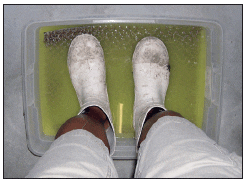
People Management
Biosecurity will be successful only if managers, staff and visitors understand and follow the necessary practices. Employees and visitors who do not follow established protocols will increase the risk of disease. Access to sensitive areas should be restricted to authorized personnel. Visitors who come to your facility immediately after visiting another aquaculture facility should be considered a serious risk.
If the workforce is large enough, personnel should be assigned specific work areas based on the age of fish, the species, and the disease status. If there aren’t enough personnel to do that, clean, healthy fish should be handled first, then diseased or possibly diseased fish, and finally, fish in quarantine. Age also plays a factor. Younger fish are considered the most susceptible, and so the order of handling should go from youngest to oldest fish.
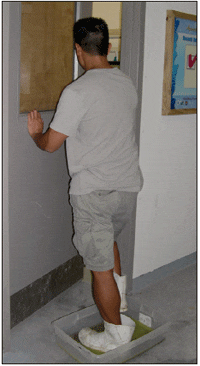
Once a biosecurity program is in place, ongoing educational programs should be provided for employees. The biosecurity program, employee compliance, diseases, and productivity should be reviewed periodically. Work with an aquatic animal health professional to develop biosecurity programs that include an educational component.
Disinfection Stations for People and Equipment
To help prevent the introduction of diseases, use disinfectant footbaths, hand-washing stations or alcohol spray bottles, net disinfection stations, showers, and vehicle disinfection stations. These should be placed in strategic locations (including at entrances and between systems) to make them easy to use and to maximize their effectiveness.
Footbaths. Commercial footbaths are available, but any shallow container or absorbent padded material can be used (Figs. 1?3) if managed properly. Virkon® Aquatic, chlorhexidine, or chlorine compounds (sodium or calcium hypochlorite) are commonly used, but chlorine is harsh on many materials. Virkon® Aquatic diluted according to instructions is considerably safer than chlorine products.
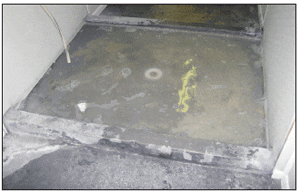
Hand washing. Hand washing alone with soap and water will remove a significant number of pathogens (Fig. 4). Using an antiseptic will further reduce risks. One option is a product with 60 to 90% alcohol, either straight rubbing alcohol (isopropyl), which can be applied with a spray bottle, or a gel product. Alcohol can dry the skin. Antibacterial soaps may also provide some level of protection, but be aware of any additives such as perfumes that might be toxic in the water.
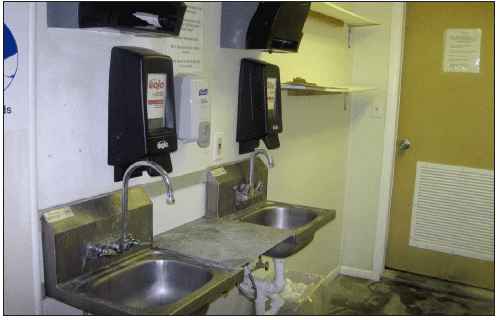
Net disinfection stations (net dips). Nets should be disinfected after use to prevent the spread of pathogens from one group of fish to another. Net dips should be sized and filled to allow complete submersion of the net and, if possible, the portion of the handle that may be submerged during use (Fig. 5). Stations should be strategically located to simplify use. Disinfectants used in net dips include QACs (which must be rinsed off after dipping) and Virkon® Aquatic.
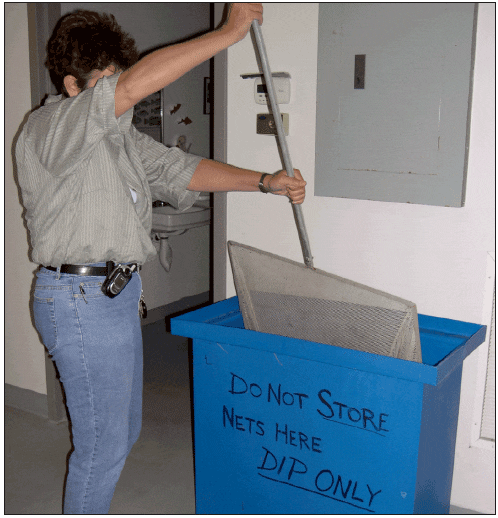
Showers. Many aquaculture facilities have showers, usually for clean up after field work. However, workers can reduce the risk of spreading diseases if they shower and change clothing and boots when moving between areas with different biosecurity levels in a facility—especially from areas with quarantined fish, diseased populations, or older life stages to areas with more sensitive or younger life stages. Workers also should shower if they work at several different facilities.
Vehicle disinfection stations. Vehicles that travel from one facility to another may transport pathogens on their wheels. Having drive-through areas filled with disinfectant at entrances and exits can help reduce this risk (Fig. 6). If a facility is known or suspected to have an outbreak of an important disease, scrubbing stations, where vehicles can be scrubbed more thoroughly with brushes and disinfectant, may be necessary.

Biosecurity Critical Control Points: Where Can Things go Wrong?
Critical control points are the physical locations or production steps at which the fish may be exposed to disease pathogens. Pathogens can enter aquaculture systems:
- on the fish
- in water
- from the environment
- on other organisms
- in commercial feeds or live or frozen foods
Each of these represents a critical control point.
Be thorough when evaluating the ways problems can arise. Activities that do not appear to be a problem can pose serious risks. For example, employees who have aquaria and handle their fish and tanks before coming to work, or who swim in nearby rivers or lakes during a break, may introduce disease through their hands or clothing. Similarly, dogs moving from one wet area to another or livestock moving between ponds can spread disease. These or other animals should not have access to production areas. This includes predators and other wildlife. Predator control and integrated pest management are critical to biosecurity.
The Aquacultured Species
Understanding the biology, behavior, genetics, ecology, social interactions, and environmental requirements of the cultured species is critical to proper management. Swimming patterns, acceptable densities, territoriality and aggression, inbreeding, light cycle, substrate, water depth and flow, and tank shape are factors which, if ignored, can cause low-level stress. Stress can then weaken fish and make them more susceptible to infections. Handling and other procedural stressors should be minimized.
It is important to know the common and important infectious and non-infectious diseases of a given species— and which life stages may be affected—so that you can develop a biosecurity plan. Work closely with a fish health professional and knowledgeable aquaculturists when developing this plan—before you have a disease outbreak. Some pathogens are common in or on healthy fish or in the environment and will cause disease only if a fish is severely stressed and/or if large numbers of pathogens are present. Examples are members of the Aeromonas or Vibrio bacterial groups and many parasites.
Eggs, fingerlings and broodstock coming from an outside supplier are a disease risk. Good suppliers will do their best to provide disease histories, testing results for specific diseases of concern, and any other important information.
Eggs may need to be disinfected. Work with a production specialist to determine the best time, drugs and protocol for egg disinfection. Egg disinfectants include iodophors such as OVADINE® (Western Chemical, Inc.) hydrogen peroxide (35% PEROX-AID®) and formalin (Noga, 2010; USFWS; JSA; OIE Manual of Diagnostic Tests for Aquatic Animals).
Fish should be sampled during quarantine. Sampling for specific diseases should be carried out when temperatures are within the correct range for those diseases. For greater assurance, a statistically significant number should be sampled by an experienced fish health professional or laboratory. The presence of some pathogens, especially some viruses, may be very difficult to verify in healthy animals.
Diet
Commercial Feeds
Commercially processed diets are not normally a source of infectious disease and should be relatively free of pathogens. However, if these feeds are stored improperly (for example, in unsealed containers in warm, moist conditions) nutrients can break down. This will cause nutritional deficiencies and increase the fishes’ susceptibility to disease. Poorly stored food also can be contaminated by pests (rats, mice, roaches) and be prone to the growth of bacteria and/or fungi. Some fungi produce mycotoxins that can cause disease in fish.
Live and Frozen Foods
Early life stages of aquacultured species are often fed live foods (copepods, rotifers, brine shrimp), but these may harbor disease-causing pathogens. Live food culture vessels should be cleaned and disinfected regularly. Various methods of reducing pathogen loads in rotifer and brine shrimp cultures have been tested. These include disinfecting the cysts with sodium or calcium hypochlorite or organic iodines, rinsing newly hatched animals with clean water before feeding, ultraviolet radiation, ozone, hydrogen peroxide, and probiotic bacteria. In pond systems, live foods are very common and, although valuable for nutrition, can be a source of disease. Work with a fish health professional and aquaculture production specialist to determine the best options for your facility.
Older life stages, including broodstock, may be fed live or frozen fish or invertebrates. These foods may also harbor pathogens and should be tested before feeding them to fish, or, if necessary, during an outbreak investigation.
Water
Good water quality is critical to the health of the fish and to the control of pathogens. System water quality and water chemistry parameters should be compatible with the species in culture and should be monitored closely for any deviations from the ideal.
Water sources have different degrees of risk. Deep wells and municipal water sources are much less likely to harbor significant levels of disease organisms than surface water and shallow wells. Water used in an aquaculture facility should be tested to make sure it is safe. If even a small amount of unsafe water is used (e.g., surface water used to prime a well pump), the entire water supply should be considered unsafe. Similarly, water used to ship fish should not be poured into the system.
Water from an unsafe source or system water can be sterilized with ultraviolet (UV) light, ozone, or chlorine.
UV sterilizers normally consist of UV-producing lamps encased in a glass or quartz sleeve, with a specific volume of water passing over the lamps at a given rate. Some designs expose large batches of water directly to banks of UV lamps. The lamps emit UV light of a particular wavelength (approximately 254 nm) that can penetrate cells and damage genetic material (RNA and DNA) and proteins.
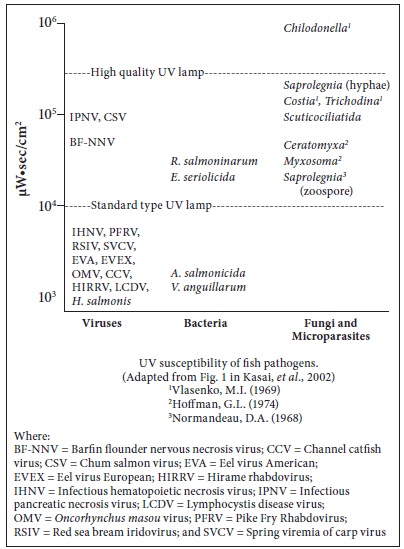
Because pathogens come in all shapes and sizes, the ideal level of UV exposure (also known as the “zap dose”) depends on the target organisms (Fig. 7 and Table 4). UV sterilizers are sized according to this desired zap dose, measured in microwatt seconds per square centimeter. The actual zap dose is determined by the intensity or wattage of the lamp, the contact time or flow rate of the water, water clarity, and the size and biological characteristics of the target organisms. Larger organisms usually require higher zap doses, but external structures and other biological features will affect susceptibility (as with some viruses, for example). In general, gram-negative bacteria require the lowest zap dose, followed by gram-positive bacteria, viruses, spore-forming bacteria, and protozoans, which require the highest zap dose. Mycobacteria can be more problematic due to clumping.
Consult a manufacturer for advice on proper sizing for a specific system and application. Follow the manufacturer’s recommendations for scheduled maintenance and bulb replacement. Bulbs lose strength over time and should be sized accordingly.
Pre- and post-UV water should be cultured to ensure that pathogens are being killed.
Another option for disinfecting water is ozone (O3) or ozonation. An aquacultural engineer and/or ozone system specialist should be consulted to help with decision making and design. Because of its high reactivity, all exposed equipment and pipe work must be able to withstand continuous exposure to ozone. Ozone can be toxic to humans and to culture species, so understand how these systems work, monitor them, use safety precautions, and train all personnel before a system is installed.
Ozone systems are more complex than UV sterilizers. Ozone generators require a high-energy field through which dry, filtered air or pure oxygen flows. After ozone is produced, it is introduced into a contact chamber—filled with water from a side stream—that is isolated from the main fish holding areas. At the right dose, ozone kills all or most pathogen life stages. After the water is exposed in the contact chamber, any residual ozone it contains is toxic and must be removed by off-gassing or carbon filtration before the water enters the main system. Ozone dissipates more rapidly in freshwater systems than in marine systems. In marine systems, some byproducts may be harmful to the fish. For example, reaction with bromine may lead to the development of highly reactive compounds that can cause skin lesions, and reaction with iodine can deplete the water of this important nutrient.
Ultraviolet Radiation Dosages for Representative Fish Pathogens. From Yanong, 2009b.

Ozone also affects other aspects of water quality. Although ozone does not appreciably convert ammonia into nitrite, it does oxidize nitrite to nitrate. If ozone is abruptly turned off, there may be a temporary nitrite spike if adequate quantities of biofilter bacteria are not present. Ozone also enhances water clarity by breaking down dissolved and particulate organics that discolor the water and that would otherwise clog the mechanical and biological filters and provide a food source for undesirable bacteria and other pathogens.
Chlorine compounds (sodium hypochlorite or calcium hypochlorite) are also often used to disinfect water supplies. The concentrations required will depend on the water source, organic loading, and pathogens targeted. Treated water should be dechlorinated (with sodium thiosulfate or another product) and then tested for residual chlorine.
Developing a Written Biosecurity Program
The most effective way to ensure biosecurity at an aquaculture facility is to develop a written biosecurity program based on risk analysis. This includes a thorough risk assessment to determine which areas or factors may cause the spread of pathogens; risk management, whereby a prevention plan is developed and carried out; and risk communication to make sure all employees, suppliers, visitors, and others who may enter the facility are educated about the plan and cooperate with it.
Appoint a facility biosecurity manager to help develop and oversee the program, and work closely with a fish health professional and aquaculture Extension specialist. They can help fine-tune your plan by identifying diseases of importance and management options based on your facility design. The program should have clear goals. It should address all potential risks and establish the corresponding corrective measures required for managing animals, pathogens and people. A biosecurity plan should be simple and easy to follow. Identify practices that are effective and practical. Complicated and burdensome plans will reduce compliance and increase frustration. A good biosecurity plan will also include a facility map and employee training programs that call for accountability and the acknowledgement of workers’ goals and duties. The written program should be given to all employees and posted in an accessible location. It should be evaluated and updated on a routine basis.
Summary
Good biosecurity measures will reduce the risk of catastrophic losses from infectious disease and low-level losses that, over time, can also greatly affect the bottom line.
Work with an experienced aquatic animal health professional, production specialist, and aquacultural engineer to develop a comprehensive biosecurity plan.
Know your fish source and water source to ensure that specific pathogens don’t enter your facility by either route. Quarantine, test, and continue to monitor fish health throughout the production cycle.
Good husbandry is key to reducing disease susceptibility.
Separate populations (lots) to reduce the spread of pathogens and disease. Different life stages should be kept in different systems.
Plan your facility’s sanitation, disinfection, and system management schemes and design your biosecurity with science, efficiency, and personnel compliance in mind.
Know your pathogens—what kinds your fish may get, how to keep them away, all the different ways these pathogens can enter the facility and/or the fish, their regulatory status, and where they can survive and thrive.
Regularly monitor systems, water quality, and fish. Isolate sick fish and remove dead and moribund fish. Know which diagnostics to use and which treatments are legal and available. Plan for depopulation and disposal.
Educate your personnel and visitors so that they understand and follow biosecurity protocols. Regularly evaluate educational programs.
Keep good records. Compliance with, and documentation of, biosecurity protocols will help reduce losses during an outbreak and may help prevent mandatory depopulation.
Always consult product labels for appropriate concentrations, use, shelf life, and safety precautions. Consult with your state environmental control agency or the hazardous waste representative at the nearest EPA regional office for guidance on the proper disposal of each product.
Further ReadingYou can view the full report by clicking here. |




